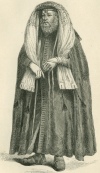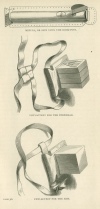
Sacred Texts Judaism Index Previous Next
Buy this Book at Amazon.com


The Talmud, by Joseph Barclay, [1878], at sacred-texts.com

Click to enlarge
A MODERN POLISH RABBI WITH TALITH AND PHYLACTERIES.
PAGE 359
Every Jew when he attains the age of thirteen years and one day becomes a bar Mitzvah (son of commandment), and is henceforth responsible for his own sins. The ceremonies connected with this event correspond to the Christian rite of confirmation. He is also bound to observe the three fundamental principles of Judaism—the wearing of the Talith, the wearing of the Phylacteries, and the observance of the Mezuza, or the Sign upon the door-posts.
The Talith, which resembles an oblong shawl, is worn over the head or shoulders. From its having four corners it is called arba canphoth. Its chief name, Tsitsith, is derived from the fringes on which its holiness depends. The Talith is made of sheep or lamb's wool, and sometimes of camel's hair. The fringes, which are of wool, carefully shorn, must be specially spun for this purpose. Four threads, of which one must (if possible) be blue, are passed through eyelet holes made in the four corners. These threads are doubled to make eight. Seven of them are of equal length, but the eighth thread must be long enough to twist five times round the rest, and after being tied into five tight knots, to have an end of the same length as the others. These five knots added to the eight threads make the number thirteen. The numerical value of the Hebrew word Tsitsith
is 600, so that the sum total is 613, which represents the 613 precepts of the oral law. These rabbinic precepts correspond to the 613 Hebrew letters of which the decalogue is composed. They are divided into 248 positive precepts, which, the Rabbis say, equal the members of the human body; and into 365 negative precepts which, they also say, equal the number of the human veins. When the Talith is put on, the Jews pray, "That it may be made through my fulfilling this precept a spiritual garment for my soul, spirit, and breath, for my 248 spiritual members, and for my 365 spiritual veins." Orthodox Jews also daily wear a smaller Talith underneath their garments, and those who are more religious allow the fringes to be seen to remind them of the 613 precepts. The Scripture on which this observance is founded is Numb. xv. 37-39, "And the Lord spake unto Moses, saying, speak unto the children of Israel, and bid them that they make them fringes in the borders of their garments, throughout their generations, and that they put upon the fringe of the border a riband (or, as the Rabbis say, a thread) of blue: And it shall be unto you for a fringe, that ye may look upon it, and remember all the commandments of the Lord and do them." Our Lord, when on earth, wore the Tsitsith, for the diseased woman touched "the hem" (fringe κρασπέδον) of His garment (Matt. ix. 20), “And he rebuked the Pharisees for their ostentation in enlarging the “borders” (fringes κράσπεδα) of their garments (Matt. xxiii. 5).
The second fundamental principle of Judaism is the wearing of Phylacteries. These are supposed by some writers to be the same as the frontlets (Tataphoth), mentioned (Ex. xiii. 16; Deut. vi. 8; xi. 18). The Totaphoth mean properly "Ornaments," and refer to the law and commandments, as understood in such passages as "Bind them about thy neck; write them upon the table of thine head" (Prov. iii. 3; vi. 21; viii. 3). And so the Karaite Jews interpret all these passages figuratively. But since their return from the
[paragraph continues] Babylonian captivity, the Rabbinical Jews insist upon their literal meaning, and they enjoin the wearing of Phylacteries (φυλακτήρια, preservatives, Matt. xxiii. 5), upon the forehead and arm of the worshipper. Phylacteries, called in Hebrew Tephillin (from Palal to pray) are, firstly, one for the forehead (Rev. xiv. 1). It is a leathern box which contains four compartments, in which are enclosed four portions of the Law written on parchment, and carefully folded. This box is made of leather, pressed upon blocks of wood specially prepared for the purpose, while the leather is well soaked in water. When it is dry and ready for use, the following passages of the law are sewn into it—(Ex. xiii. 1-10,11-16; Deut. vi. 4-9; xi. 13-21). On this box there is also impressed the letter ש (Shin), with three strokes for the right hand side of the wearer, and also the same letter with four strokes for the left hand side of the wearer. Secondly, there is another leathern box, without any ש (Shin), for the arm of the worshipper, and with only one compartment, into which the same passages of Scripture are sewn with the sinews of animals, specially prepared for this object. The phylacteries are bound on the forehead and arm by long leathern straps (R’tsuoth) which pass through the Maabarta, or passages in their sides. The straps round the head must be tied in a knot shaped like the letter ד (Daleth). And the straps on the arm must be long enough to go round it seven times, and three times round the middle finger, with a small surplus over in the form of the letter י (Yod). There is thus formed by the letter Shin on the phylactery, and by the knot Daleth on the back of the head, and by the Yod on the hand the word Shaddai, or Almighty. This is said to fulfil the text, "And all people of the earth shall see that thou art called by the name of the Lord (or as the Rabbis say, 'the name of the Lord is read upon thee'), and they shall be afraid of thee" (Deut. xxviii. 10). The time for putting on the phylacteries is during the day, at the time of prayer and reading of the Shema, or "Hear O Israel," etc. (Deut. vi. 4, etc.) They are not to be worn at night, on the Sabbath, or on the festival days, because it is said, "And it shall be for a sign"
[paragraph continues] (Ex. xiii. 9). As the Sabbaths and festivals are signs in themselves, no other signs are needed. The phylacteries are to be kept in special bags with the greatest reverence. The Rabbis assert that they are worn by God, and "that the single precept of the phylacteries is equal to all the commandments."
The third fundamental principle of Judaism is Mezuza, or Sign upon the door post. This precept is founded upon the command, "And thou shalt write them upon the posts of thy house, and on thy gates" (Deut. vi. 9; xi. 20). The door-posts must be those of a dwelling-house; and accordingly, Maimonides mentions ten different things which are requisite to constitute a dwelling-house. Public buildings, such as synagogues, are excluded from this command. The Karaite Jews reverse this order, and affix Mezuzas to synagogues but not to private houses. The way in which Mezuzas are made is as follows:—Two portions of Scripture (Deut. vi. 4-9; xi. 13-21) are written on ruled vellum which must be prepared according to Rabbinic rules. This vellum is rolled up so as to fit into a cylindrical tube of lead or tin. The word Shaddai (Almighty) is written on the outside of the roll, and a section is cut from the tube, so that Shaddai may be clearly seen. It is then nailed through both its ends to the door posts of all the apartments on the right hand side. Those who enter are thus reminded that the eye of God is upon all their doings. Under the word Shaddai, some Jews write the three angelic names, Coozu, Bemuchsaz, Coozu; and to these three angels they even pray for success in business. When the Mezuzas are being fastened to the door-posts the following prayer must be used, "Blessed art thou, O Lord our God! King of the universe, who hath sanctified us with His laws, and commanded us to fix the Mezuza."
The Talmud estimates the virtue of the Talith, the phylacteries, and the Mezuza in the following terms:—

Click to enlarge
MEZUZA AND PHYLACTERIES.
MEZUZA, OR SIGN UPON THE DOOR-POST
PHYLACTERY FOR THE FOREHEAD
PHYLACTERY FOR THE ARM.
PAGE 362
[paragraph continues] “Whoever has the phylacteries bound to his head and arm, and the fringes thrown over his garments, and the Mezuza fixed on his door-post, is safe from sin: for these are excellent memorials, and the angels secure him from sin; as it is written, “The angel of the Lord encampeth round about them that fear Him and delivereth them” (Ps. xxxiv. 7).
If, instead of resting in the mere routine of these observances, which they too often do, the eyes of Israel were enlightened by the Holy Ghost, they would see them to be shadows of glorious truths. The Talith would be seen as a symbol of the imputed righteousness of Christ, who has fulfilled the law. The phylacteries would appear as symbols of the necessity of having God's Word engraven both on head and heart. And the Mezuza would be regarded as a symbol of the omniscient eye of an holy God from whom nothing can be hidden or unknown.